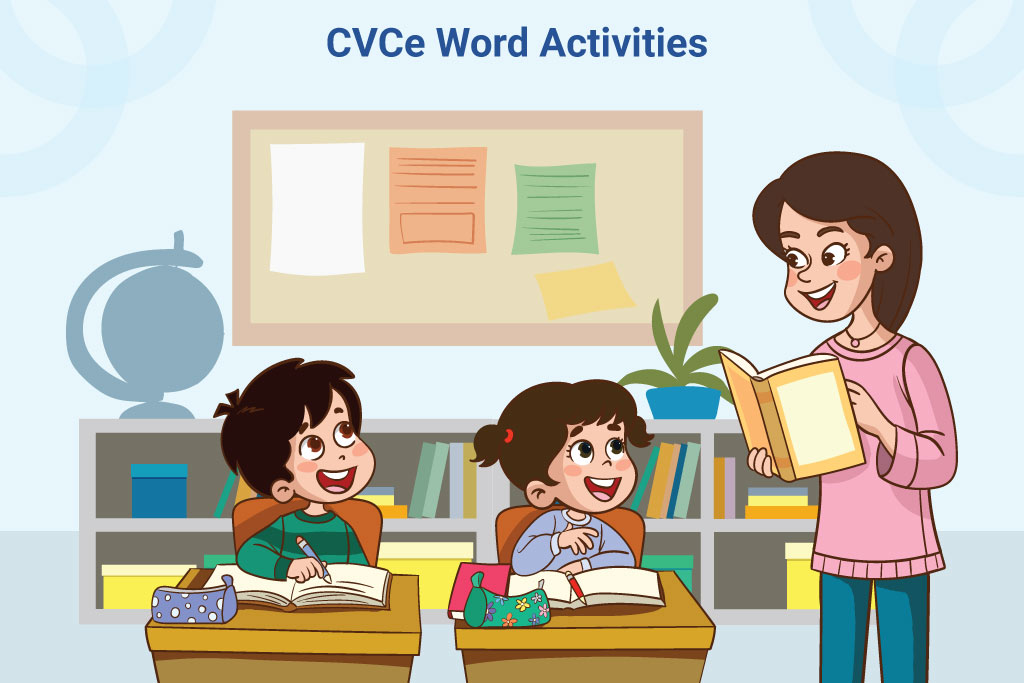13 Interesting CVCe Word Activities

CVCe words, also known as magic “e” words, follow the consonant-vowel-consonant-e pattern. The silent “e” at the end changes the vowel sound from short to long, transforming words like “cap” into “cape” or “bit” into “bite.” It is important to learn these words for early literacy development. Interactive games and hands-on activities can help teachers introduce CVCe words in a fun and effective way. Students learn pronunciation patterns and spelling rules naturally, with engaging methods, their phonics knowledge is reinforced, and their reading skills are improved.
If you want interesting and effective methods to teach CVCe words to children, read this blog till the end.
1. CVCe Word Art
Word art is one creative way to reinforce CVCe words. Students can draw CVCe words in bubble letters and decorate them with colours, stickers, or drawings for the meaning of the word. Using this visual approach helps learners remember spelling patterns and strengthens word recognition. Another fun variation is to use magazine cutouts to make CVCe words tactile and engaging. Students gain a deeper connection with the words and have fun at the same time when they add creativity.
2. CVCe Word Bingo
CVCe word practice is made interesting with Bingo. Teachers make bingo cards with different CVCe words and the words are called out randomly. Students hear a word, find and mark it on their cards. The first to complete a row shouts “Bingo!” This activity is helpful for listening skills and word recognition. Teachers can use pictures instead of words so that students can match spoken words with the matching pictures to add variety. It becomes more interactive and engaging.
3. CVCe Word Matching
This activity has students match CVCe words with pictures or definitions. Teachers can make flashcards with words on one set and images on the other. In each pile, students take turns drawing a card and looking for a match. This game helps to retain vocabulary and reinforces understanding of CVCe words in context. To add some extra challenge, a timed version can be introduced, which forces quick thinking and recall.
Want to Make Reading Fun for Kids? Explore These Ideas!
4. CVCe Word Board Game
A custom board game with CVCe words makes learning exciting. Players move along a path by reading and correctly pronouncing words in each space. Some spaces can include challenges, like using the word in a sentence or spelling it aloud. The first player to reach the finish wins. This activity strengthens reading fluency while fostering a playful learning environment. With creative themes like “Magic E Adventure,” students stay engaged and motivated. The best jolly phonics teacher training course can help educators implement such activities effectively.
5. CVCe Word Puzzles
Puzzles are a great way to reinforce spelling patterns. Teachers can create word searches, crosswords, or jigsaw puzzles using CVCe words. Students can also piece together letter tiles to form words. These activities challenge learners to think critically while improving word recognition. Word-building puzzles encourage students to analyze phonics patterns, helping them decode similar words in reading practice.
6. CVCe Word Flashcards
Flashcards remain one of the simplest yet most effective tools for learning CVCe words. Each card features a word on one side and an image or sentence on the other. Teachers can use them for quick recall games, timed challenges, or partner activities. This method enhances visual memory and strengthens vocabulary. Flashcards also serve as a useful tool for phonics training for teachers, ensuring students grasp spelling and pronunciation rules efficiently.
7. CVCe Word Art
A CVCe word wheel is a rotating tool that helps students form different words by changing the beginning consonant. For example, a wheel featuring “-ake” can create “bake,” “cake,” and “lake” by spinning the wheel. This hands-on approach allows students to see spelling patterns in action, making it easier to recognize and apply phonics rules. Word wheels encourage self-guided learning and exploration. For more engaging exercises, teachers can incorporate fun phonics activities.
8. CVCe Word Sort
Sorting activities help students categorize words based on similar phonics patterns. Teachers provide word cards, and students group them by vowel sounds or word endings, such as “-ide,” “-ope,” and “-ave.” This activity enhances pattern recognition and spelling skills. To make it more engaging, students can compete to sort words the fastest or sort them into fun themes.
9. CVCe Word Relay Race
Incorporating movement into learning makes it more memorable. In this activity, students race to match CVCe words with pictures or definitions. Teachers set up word stations around the room, and students must run to find the correct word and bring it back. This high-energy game reinforces vocabulary in a fun and interactive way while promoting teamwork.
10. CVCe Rhyming Challenge
Rhyming games help students recognize phonics patterns. Teachers provide a CVCe word, and students take turns finding words that rhyme with it. For example, if the word is “stone,” students might say “cone,” “bone,” or “phone.” This activity strengthens phonemic awareness, an essential skill for reading fluency. Adding a timer or competition element increases excitement.
11. CVCe Word Search
The effectiveness of word searches are a great way to reinforce spelling. Teachers create grids filled with CVCe words for students to find. Searching for words strengthens visual recognition and improves concentration. To add a challenge, students can write sentences using the found words, reinforcing comprehension alongside word recognition.
12. CVCe Word Train
Students create a “train” by connecting CVCe words that share common sounds or letters. For example, “ride” can link to “wide,” which connects to “side.” This activity visually demonstrates word relationships and helps students understand phonics patterns. Using word strips or magnetic letters enhances hands-on learning.
13. Write and Illustrate
Encouraging students to write and illustrate sentences using CVCe words strengthens comprehension. For example, they can write, “The kite flies high,” and draw a picture to match. This method enhances creativity while reinforcing word meanings in context. Such fun teaching activities engage students in literacy development beyond memorization. Teachers looking for structured guidance on phonics instruction can explore how to teach phonics to kids.
Want to Make Reading Fun for Kids? Explore These Ideas!
Conclusion
Mastering CVCe words is crucial for early readers. Engaging activities like games, puzzles, and interactive challenges make learning enjoyable and effective. By incorporating creative methods, teachers can teach phonics to kids in an exciting way, ensuring long-term retention. With consistent practice, students develop confidence in reading and spelling, setting a strong foundation for literacy success.

Hema Dave
Stemming from the aspiration to nurture and inspire young minds, Hema started her professional journey into education 20+ years ago. She founded 'Phonic Smart' as a trained educationist, an institute committed to equipping children with phonics skills and helping parents and teachers implement them effectively. Her diverse skill sets, encompassing teaching, teacher training, and coaching allow her to contribute valuable insights to the education industry.

